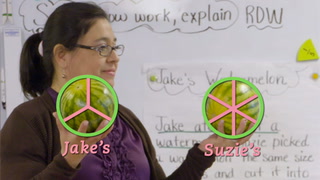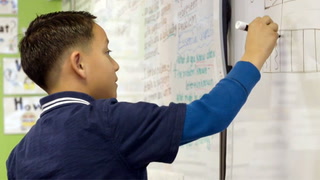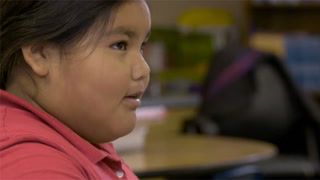Series Connecting Math to Real-World Tasks: Launching a Fractions Task
Math.4.NF.B.3a
| Common core State Standards
- Math: Math
- 4: Grade 4
- NF: Number & Operations--Fractions
- B: Build fractions from unit fractions
-
3a:
Understand a fraction a/b with a > 1 as a sum of fractions 1/b.
a. Understand addition and subtraction of fractions as joining and separating parts referring to the same whole.
b. Decompose a fraction into a sum of fractions with the same denominator in more than one way, recording each decomposition by an equation. Justify decompositions, e.g., by using a visual fraction model. Examples: 3/8 = 1/8 + 1/8 + 1/8 ; 3/8 = 1/8 + 2/8 ; 2 1/8 = 1 + 1 + 1/8 = 8/8 + 8/8 + 1/8.
c. Add and subtract mixed numbers with like denominators, e.g., by replacing each mixed number with an equivalent fraction, and/or by using properties of operations and the relationship between addition and subtraction.
<br />
d. Solve word problems involving addition and subtraction of fractions referring to the same whole and having like denominators, e.g., by using visual fraction models and equations to represent the problem.
Grade 4 expectations in this domain are limited to fractions with denominators 2, 3, 4, 5, 6, 8, 10, 12, 100.
Math.4.NF.B.3c
Common core State Standards
- Math: Math
- 4: Grade 4
- NF: Number & Operations--Fractions
- B: Build fractions from unit fractions
-
3c:
Understand a fraction a/b with a > 1 as a sum of fractions 1/b.
a. Understand addition and subtraction of fractions as joining and separating parts referring to the same whole.
b. Decompose a fraction into a sum of fractions with the same denominator in more than one way, recording each decomposition by an equation. Justify decompositions, e.g., by using a visual fraction model. Examples: 3/8 = 1/8 + 1/8 + 1/8 ; 3/8 = 1/8 + 2/8 ; 2 1/8 = 1 + 1 + 1/8 = 8/8 + 8/8 + 1/8.
c. Add and subtract mixed numbers with like denominators, e.g., by replacing each mixed number with an equivalent fraction, and/or by using properties of operations and the relationship between addition and subtraction.
<br />
d. Solve word problems involving addition and subtraction of fractions referring to the same whole and having like denominators, e.g., by using visual fraction models and equations to represent the problem.
Grade 4 expectations in this domain are limited to fractions with denominators 2, 3, 4, 5, 6, 8, 10, 12, 100.
Save to My Resources
PLEASE CREATE A NEW ACCOUNT OR LOG IN TO ACCESS THIS CONTENT
Enjoy your first video for free. Subscribe for unlimited access.
Have questions about subscribing?
Click Here to learn more about individual subscriptions.
Click Here to learn more about School and Institution access.
Discussion and Supporting Materials
Thought starters
- What do students do before getting the task?
- How does Ms. Linares make sure students understand the problem?
- What do you notice about how Ms. Linares balances time for both individual and group work?
In Partnership With:


School Details
Orange Grove Elementary School3525 West County 16 1/2 Street
Somerton AZ 85350
Population: 484
Data Provided By:

Teachers
Patty Linares
Newest
|
4 MIN
|
5 MIN
|
5 MIN
UNCUT CLASSROOMS
| TCHERS' VOICE
English Language Arts













11 Comments
Miranda Garcia Feb 12, 2020 10:28am
Before the students get the task they are asked about prior knowledge on the subject, in this particular case they are sked to share within their group what they already know about fractions.
Ms. Linares makes sure the student understnds the problem by providing visuals, discussing the problem as a group, and underlining kiy elements in the problem.
Ms. Linares balances individual and group work by having the class dicuss elements of the problem as a whole class while still calling on individuals, as well as having the class split into small groups and checking in with individuals in those small groups.
Diane Gentle Feb 10, 2018 7:13pm
Stephanie Smith Jan 23, 2018 5:25pm
maisoun mando Jul 10, 2017 11:19am
Karen Iris Mar 1, 2017 9:56pm